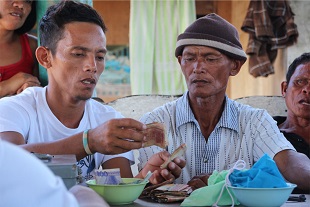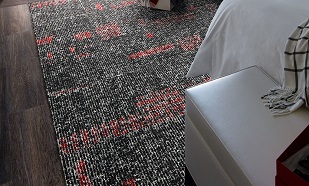LAGRANGE, GA.—It was more than 20 years ago that Interface, the maker of carpet tile, set a very ambitious goal: to have no negative impact on the planet by the year 2020. It called its decades-long project “Mission Zero.” With less than three years to go until 2020, Green Lodging News spoke with Interface’s Mikhail Davis to learn how close the company is to reaching its goal. Davis, based in San Francisco, is Director of Restorative Enterprise and a Certified Biomimicry Specialist.

Davis says two of Interface’s key metrics are energy use per unit of production and how much of that energy is renewable. Since 1996 Interface has reduced energy use per unit of production by 45 percent. Globally, the company uses 84 percent renewable energy. In the Americas that amount is 96 percent. In Europe it is 96 percent and above. In the Americas Interface has been able to approach 100 percent renewable energy because of the addition of directed biogas to meet the thermal energy needs of the company’s flagship operations in Troup County, Ga.
Globally, greenhouse gas emissions are down 92 percent since 1996. Water consumption is down 87 percent, and waste to landfill is down 91 percent per unit of production.
In 1994, Ray Anderson, the founder of Interface, had the realization that his business needed to change from a “take-make-waste” model to a circular model—one where there is no waste and ultimately to a model where the company is actually restorative.
Focus on Source Materials
Interface’s goal is to have 100 percent of its source materials from bio-based or renewable sources. Davis says the company currently stands at 64 percent. It increased the percentage from 50 percent to 64 percent in just 12 months. “We are looking at getting more of our materials back,” he says. “Right now it is not coming back in sufficient quantity. We are looking more at bio-based material. We are already switching out petrochemical products used in the backing of carpet tile.”
“The biggest thing driving your impact is the materials,” David adds. “We want to use as little material and as good a material as we can.” Interface’s standard yarn is now 100 percent recycled nylon.

One example of a material being reused by Interface is Poly Vinyl Butral (PVB), the laminate material that prevents car windows from shattering. All standard microtuft carpet tiles are now produced with a recycled PVB precoat. Interface is able to reduce the carbon footprint of its carpet tiles and extend the useful life of PVB at the same time.
Another material example is discarded fishing nets. Interface has partnered with the Zoological Society of London to buy discarded fishing nets from some of the poorest communities in the world. The nets are recycled into new yarn for carpet tiles by Aquafil. The benefits? Fewer ghost nets, less virgin materials and a new source of income for the communities. The partnership has created an inclusive business model with positive outcomes for everyone involved. The program started in the Philippines and was expanded to Cameroon in 2015. “The Net-Works program has been great,” Davis says.
Staying away from petroleum-based materials is a key Interface objective. Plastics made from sugars to corn have been explored so far. “We would rather have a win rather than switching from one bad material to another,” Davis says.
Internal Carbon Tax Created
Interface has reduced its product carbon footprint by 60 percent since 1996. Its goal is 80 percent by 2020. “We created an internal carbon tax to offset CO2 emissions,” Davis says. The company’s Cool Carpet program enables Interface customers to have a carbon-neutral floor. Cool Carpet is third-party verified and reviewed annually by SGS. Cool Carpet certificates show the quantity of carbon offsets associated with a purchase.
When asked if hotel company customers look as deeply at sustainability as they do, Davis cited Marriott International as one example of a company that “looks very deep indeed.”
“Marriott has been requesting very in-depth information from its FF&E suppliers,” Davis says. “Marriott is interested in the supply chain and anything that has an impact on hotel operations or guest health.”
Davis says hotel companies have been asking about packaging in particular. “Our customers have to deal with the packaging,” he says.
How to Get Beyond Zero
 As Interface approaches its 2020 goals, Davis says it is actually the company’s goal to figure out how to get beyond zero on some of its goals. “How do we turn our company into a solution for climate change, or a force to alleviate poverty? At the factory level, how do we get to where factories are sucking up carbon?” He adds, “The goal now is to be like a forest. Can we be functionally as good as a forest?”
As Interface approaches its 2020 goals, Davis says it is actually the company’s goal to figure out how to get beyond zero on some of its goals. “How do we turn our company into a solution for climate change, or a force to alleviate poverty? At the factory level, how do we get to where factories are sucking up carbon?” He adds, “The goal now is to be like a forest. Can we be functionally as good as a forest?”
“What we really should be reporting on is how much carbon we take out of the atmosphere,” Davis says.
When asked if there is a particular trend he is seeing currently as it relates to product sustainability, the Certified Biomimicry Specialist said there has been an increased focus on ingredients and health questions related to them.
Glenn Hasek can be reached at editor@greenlodgingnews.com.






